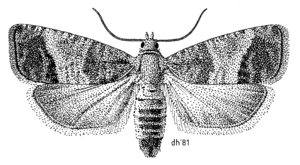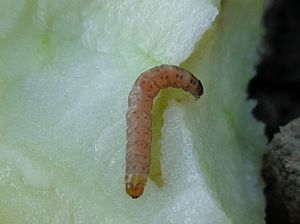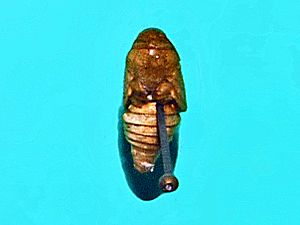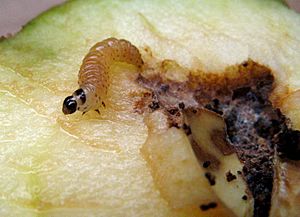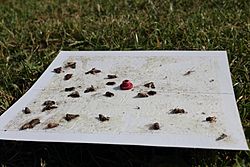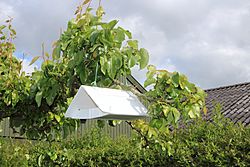Codling moth facts for kids
Quick facts for kids Codling moth |
|
|---|---|
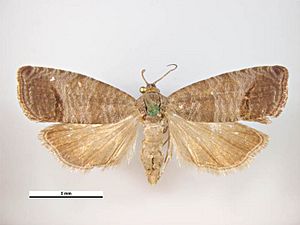 |
|
| Male | |
 |
|
| Female | |
| Scientific classification | |
| Genus: |
Cydia
|
| Species: |
pomonella
|
| Synonyms | |
|
|
The codling moth (Cydia pomonella) is a small moth. It belongs to a group of moths called `Tortricidae`. These moths are a big problem for farmers. They are known as `pests` because their young, called caterpillars, damage fruit crops. They especially like `apples and `pears.
Codling moth caterpillars cannot eat leaves. This means they must find fruits to survive. When they bore into a fruit, it stops the fruit from growing properly. This often makes the fruit ripen too early. People use different methods to control these moths. These methods include using chemicals, natural enemies, and prevention. This moth lives in many parts of the world. It can be found on six continents. The moth can also adapt to tough conditions. For example, it can enter a resting state called `diapause`. It can also have many generations in one year. This helps it survive even when the weather is bad.
Contents
Where Codling Moths Live
We are not sure exactly where codling moths first came from. Some people think they started in `Europe`. Others believe they came from the Mediterranean area. Scholars think these moths arrived in the Americas in the mid-1700s. There is still a discussion about whether humans helped spread these moths around.
Today, codling moths are found all over the world. You can find them in Europe, Asia, `Africa`, `North and South America`, `Australia`, and `islands in the Pacific`.
Codling Moth Homes
Codling moths need certain conditions to live and grow well. They do best in warm and humid places. Studies show that 32 °C (about 90 °F) and 75% humidity are perfect for them. If the humidity is too low (20%) or too high (100%), it can stop them from turning into a `pupa`.
If the temperature drops below 0 °C (32 °F), the caterpillars become completely still. They look like they are not alive. But if the temperature goes back to normal, they become active again. Codling moths have been found living in high places, up to 1000–1500 m (about 3,300–4,900 feet) high.
Codling moths are `polyphagous`. This means they can eat many different kinds of food. So, they don't need a specific food source to find a good home. You can find the moths at different life stages, from eggs to pupae, on the plants their caterpillars eat. These plants include apple, pear, walnut, chestnut, and even apricot trees.
What Codling Moths Look Like
Adult codling moths are not very big. A full-grown moth is about 10 mm (0.4 inches) long. Its wings can spread up to 20 mm (0.8 inches) wide. When the moths are resting, their wings fold like a tent.
You can tell them apart from other similar moths by the special patterns on their front wings. These wings have brown spots with gold rings. People call these spots "little mirrors" because they look like small mirrors with a golden edge. The moths have thin `antennae` that curve slightly at the ends. The top of their body is smooth. The underside is covered in tiny scales. Most codling moths are brown or gray. However, the color of the fruit the caterpillars eat can change the color of the adult moth.
What Codling Moths Eat
Caterpillar Feeding Habits
Codling moth caterpillars bore into a fruit very quickly. They usually do this within 24 hours of hatching. They travel about 1.5 to 3 meters (5 to 10 feet) to find a fruit. Caterpillars need to find a fruit fast. This is because they can be eaten by other animals, dry out, or be washed away by rain.
Apples are their favorite food. But they can eat many other fruits. These include `pears, `walnuts, `apricots, `peaches, `plums, `cherries`, and `chestnuts. They cannot live by eating only the leaves of fruit trees.
Scientists used to think caterpillars searched for fruit randomly. But caterpillars are in danger during this search. They can be eaten, get sick, or run out of energy. So, it is now believed they use special senses to find fruit. They use a `thigmotactic` sense, which means they use touch to find their way. They also use `phototaxis`, meaning they move towards light. This helps them find fruits, which are often at the ends of branches where there is more sunlight.
Once a caterpillar finds a fruit, it starts to dig into the fruit's outer skin, called the `epidermis`. As it digs, small pieces of skin, fruit pulp, and waste (called `frass`) build up at the hole's entrance. The caterpillar uses silk threads to glue these pieces together. This creates a cap that blocks the entrance. This cap protects the caterpillar. It takes about 45 minutes for the caterpillar to bore into the fruit. It takes about 15 minutes to make the cap.
The caterpillar digs through the fruit until it reaches the seeds. It bites into the seeds, which stops the fruit from growing. As a result, the fruit ripens too early. By doing this, the caterpillar gets important nutrients like `albumin` and `fat`. This feeding lasts for about 23 to 27 days. During this time, one caterpillar usually eats one or two fruits.
How Fruits Fight Back
Fruits attacked by codling moth caterpillars have ways to protect themselves. Some fruits make their skin thicker. Others use hard cells, called stony cells, to protect their seeds. Fuzzy fruit surfaces have also been seen to stop codling moth caterpillars.
Stony cells are found in some pears. They help resist the caterpillars. These cells are also in the inner layer of fruits like cherries or walnuts. In pears, stony cells are found in groups within the fruit's flesh. These cells have thick walls, up to 10 µm (micrometers) thick. When they are fully grown, these cells are made of `cellulose`, `glucuronoxylans, and `lignin`. These are strong materials found in plants.
Adult Moths and Food
Adult codling moths eat very little, if at all. Eating might make them live a little longer. However, not eating does not greatly affect their ability to have babies.
Codling Moth Life Cycle
How Many Generations?
The number of generations a codling moth has each year depends on the weather. In warmer places closer to the equator, there are more generations. For example, in `Denmark`, there is usually only one generation. But in `Palestine`, there can be four or five generations. In most parts of Europe and North America, there are usually two generations during the summer months.
The first generation of moths comes out in July and is active through August. The eggs laid by these moths are called the second generation. These eggs hatch, and the caterpillars turn into pupae. These pupae then go into a resting state called `diapause` for the winter. In April and May of the next year, these second-generation pupae emerge as moths. These second-generation moths are active during May and June.
Mating Habits
Male moths fly upwards near the tops of trees to find females. Females tend to stay close to the trees where they hatched. Female moths release a special scent called codlemone. This scent attracts males. Other plant smells can also mix with codlemone. This makes the scent even stronger and attracts more males. These plant smells include `linalool`, `farnesene`, or `hexenol`. The best mix for attracting males is one part codlemone to 100 parts of these plant smells.
A special scent from pears also attracts codling moths. This scent, called ethyl (2E, 4Z)-2,4-decadienoate, is found in ripe pears. It is also a small part of the smell from ripe apples. This scent attracts both male and female moths, whether they have mated or not.
Laying Eggs
Female moths lay their eggs where the climate and humidity are best for the eggs to grow. About 75% humidity is ideal for laying eggs. Females are more likely to `lay eggs` if there is water, fresh fruits, or even molasses nearby. How many eggs a female lays depends a lot on the weather. If it's too cold, she stops laying eggs. If it's too hot, she might not be able to have babies at all.
Females usually don't travel far to lay eggs. They often lay them near the tree they came from. On average, a female lays 50–60 eggs. But this number can change. She might lay as few as ten or more than 100 eggs. First-generation eggs are laid on fruits. Second-generation eggs are usually laid on twigs and leaves. Females prefer to lay eggs on the upper parts of trees, near the ends of branches. This is where fruits are most common. The female also releases a sticky substance with the eggs. This glue holds the eggs in place and stops them from being washed away by rain.
Life Stages of the Codling Moth
Egg Stage
The eggs are laid on either the fruit or a twig. They are white and shaped like a `convex lens`. They are very tiny, about 1–1.2 mm (0.04–0.05 inches) in size. As the caterpillar grows inside the egg, the egg changes color. First, a reddish ring appears. Then, a red spot forms, which becomes the caterpillar's head. It usually takes about 7 to 12 days for the eggs to hatch. But in perfect conditions, they can hatch in as little as 5 days.
Caterpillar Stage
When a caterpillar first hatches, it is about 2 mm (0.08 inches) long and 0.5 mm (0.02 inches) wide. Its body has twelve parts. It is usually pale yellow. As the caterpillar grows through five stages (called instar phases), it becomes 18–20 mm (0.7–0.8 inches) long. It also turns more reddish. By the time they are fully grown, caterpillars are light brown with dark brown spots.
The sex of the moth is decided during the caterpillar stage. Codling moths have two sets of chromosomes (2n=56). This means they get one set from each parent. Female moths have WZ sex chromosomes, while males have ZZ. Male caterpillars have two brown spots near the end of their back. These spots will become their reproductive organs.
Eggs can hatch at night or during the day, depending on the humidity. If a caterpillar hatches during the day, it moves into the shade or crawls to the bottom of a leaf. This is because direct sunlight can dry out the caterpillar and make it too hot. The eggs are glued to the leaf by the sticky substance from the female moth. However, the caterpillars are small and light. They can be washed away by rain or blown off the tree by wind. Young caterpillars are especially sensitive to rainy summers. Data shows that moths attacked fewer crops in rainy summers.
Pupa Stage
The pupae are 10–12 mm (0.4–0.5 inches) long and up to 3 mm (0.12 inches) wide. Their color changes over time. They start brown, like the caterpillar, then become light brown. The pupa's shape changes depending on its sex and which generation it belongs to. Female pupae are usually longer and wider than male pupae.
First-generation caterpillars make smoother, more delicate silk for their cocoons. So, their cocoons are covered with finer material. Second-generation cocoons are rougher and have pieces of tree `bark`. This is because second-generation caterpillars dig into the tree bark to make their cocoons.
The fully grown caterpillar looks for a place near the ground to spin its `cocoon`. It uses its silk threads to lower itself from the branches to the ground. They can also crawl down the tree trunk. Finding the right place to turn into a pupa takes a long time. Pupae have been found in many places. These include under old bark, in cracks, in dry ground, in ditches, in fruit storage areas, on tree trunks, under rocks, and between `clods` of soil.
For first-generation caterpillars, the pupa stage is shorter, usually less than ten days. For the second generation, it lasts longer, around 20 days. This difference is due to temperature changes as the season goes on. Warmer temperatures make the pupa stage shorter. So, first-generation caterpillars, which appear in warmer summer months, have a shorter pupa stage. Some second-generation caterpillars stay as pupae over winter. They emerge as first-generation moths in the spring. The cocoon protects them from rain and other outside dangers, but not from physical damage.
Adult Moth Stage
Second-generation adult moths first appear in the spring. This is usually around late April to early May in the Northern Hemisphere. In the Southern Hemisphere, it's around September/October. When they fly and emerge depends on temperature and other weather factors. As soon as the moths emerge, they mate. Then they lay first-generation eggs. The caterpillars from these eggs bore into fruits. So, it's important to know when the moths will emerge in spring. This helps farmers protect their crops.
The moth's body has sharp notches. These help the moth cut through the pupa's outer layer to emerge. When moths first emerge, their wings are not fully spread. So, they cannot fly right away. It takes about ten minutes for their wings to fully open.
An adult moth usually lives for about 13 to 18 days. However, the longest-living male moth observed lived for 38 days. The oldest female lived for 37 days.
Diapause: A Resting Period
`Diapause` is a time when codling moth caterpillars stop developing. This happens if the weather or food supply is bad. Caterpillars in diapause do not spin cocoons. Instead, they enter a state where their body processes slow down. When the temperature drops below 0 degrees Celsius (32 degrees Fahrenheit), the caterpillar becomes still. It becomes very soft, like heated wax or clay. If you poke it, the dent stays there.
For first-generation caterpillars, more of them went into diapause if they did not turn into pupae by late June or early July. Second-generation caterpillars usually go into diapause to survive the winter. Cold temperatures cause this inactivity. When the temperature and humidity become favorable again, they become active. This explains how codling moths can survive even if there is a year with few apples. The caterpillars go into diapause and emerge after the bad year has passed.
Scientists have discussed if diapause can last for two years. However, it seems unlikely. Out of 15,000 cocoons studied, none of the caterpillars emerged after a two-year diapause.
How Moths Move Around
Adult codling moths start flying around early May. This is when the second-generation moths emerge. They stop flying around late August, as the first-generation moths get old. The flight times of the first and second generations overlap for about 10 to 20 days. This overlap means that codling moths cause continuous damage during the summer.
Adult moths usually stay in one place. They spend the day resting on leaves or branches. They can fly long distances, even several kilometers. However, most moths travel only between 60 and 800 meters (about 200 to 2,600 feet). Only about 10% of them are long-distance travelers. This ability to fly different distances helps them survive. Their home is usually where there is fruit. So, they don't need to fly far. But if fruits are spread out, they can travel longer distances to find food and start new groups.
Young females and males that have not mated are more likely to fly longer distances. Both sexes can travel about the same distance. Unmated males and females, and mated males, fly the longest during the first third of their adult lives. Mated females fly the most within 1–3 days after they emerge.
There is a strong link between how far a moth flies and how long and fast it flies. These flight traits can be passed down from parents to offspring. Studies show that selecting for or against these flight traits can quickly change how moths fly. However, there is a trade-off between flying a lot and having many offspring. Research shows that female moths that stay in one place have more offspring than those that fly a lot. Females that stay put are larger, lay more eggs, and live longer. This means they have more babies. This explains why females do not fly far from the fruit tree where they hatched to lay their eggs.
Enemies of the Codling Moth
Predators
Birds are the main predators of codling moths. They kill almost 80% of the caterpillars. `Woodpeckers are especially important. They find caterpillars hidden in cracks under the bark and branches of trees. Many `arthropods also eat codling moths. These include `spiders`, `harvestmen`, `ground beetles`, `tiger beetles`, `earwigs`, `ants`, big-eyed bugs, `rove beetles`, and other `beetles`.
Ants are some of the most important insect predators. They are many in number and work together. They attack all stages of the codling moth's life cycle. This includes caterpillars, pupae, cocoons, and emerging moths. Some common ant predators are Solenopsis molesta, Lasius niger, Formica fusca, Formica pallidefulva schauffussi inserta, Aphaenogaster fulva aquia, Tetramorium caespitum, and Monomorium minimum. Solenopsis molesta can kill 90% of the caterpillars they attack. These are usually caterpillars moving between fruits or those looking for a place to turn into a pupa.
`Thrips` also eat codling moths at different life stages. Haplothrips faurei eats eggs from all generations. Leptothrips mali eats second-generation eggs.
Parasitoids
The egg stage is the most dangerous time for the codling moth. This is because the egg is exposed for the longest time. Caterpillars are protected inside the fruit. Pupae are protected by their cocoons. Here are some insects that are `parasitoids` of the codling moth:
- Arrhinomya tragica (pupa) – a `fly`
- Neoplectops veniseta (pupa) – a `Tachinid fly`
- Ephialtes extensor (caterpillar) – a `Ichneumonidae` wasp that attacks both generations. It stays inside second-generation caterpillars over winter.
- Hyssopus pallidus (larva) – these wasps follow the scent (kairomone) from the caterpillar's waste as it bores into the fruit.
- Lissonota culiciformis – another `Ichneumonidae` wasp
- Mastrus ridens – another Ichneumon wasp
- Pimpla examinator (caterpillar and pupa) – another Ichneumon wasp
- Pristomerus vulnerator (caterpillar) – another Ichneumon wasp that attacks both generations.
- Trichomma enecator (caterpillar) – another Ichneumon wasp
- Ascogaster nov. sp. (egg or pupa) – another Ichneumon wasp. A pupa that has been parasitized might die or emerge as a small adult. Perilampus tristis, a `Chalcidoid wasp`, is a `hyperparasite` of this Ascogaster species. This means it parasitizes the parasitoid.
Diseases
Fungi
Beauveria bassiana is a fungus that attacks codling moth caterpillars and pupae. The tiny spores of this white fungus spread where caterpillars move or where they turn into pupae. The fungus grows out from the caterpillar's body, making the caterpillar soft and mushy. It can kill about 13.1% of caterpillars. B. bassiana grows best in humid and warm places.
Hirsutella subulata is another fungus that eats insects. It attacks codling moth larvae. Unlike B. bassiana, this fungus can grow even when the humidity is low.
Bacteria
Some bacteria are known to attack the codling moth. These include Erwinia amylovora and Bacillus cereus. B. cereus attacks the larvae of the codling moth.
Granulovirus
`Baculoviruses` are common `viruses` that infect moths and butterflies. They are divided into two groups: `Nucleopolyhedrovirus` and `Granulovirus`. One type of granulovirus is specific to codling moths. Granuloviruses form small particles, each carrying one virus. They are called 'slow' or 'fast' depending on how quickly they kill the host. Fast-killing granuloviruses usually kill the host during the same stage (instar) they were infected.
Cydia pomonella granulovirus is a fast granulovirus. It is deadly to codling moths. Because it is fast, the codling moth larvae die in the same instar they were infected. Scientists have mapped out the full genetic code of Cydia pomonella granulovirus. It has 123,500 base pairs.
Three main types of Cydia pomonella granulovirus have been found: M, E, and R. These can be sorted into four genome types: A, B, C, and D. Scientists think genome C is the oldest type. Genome C is also less harmful to newly hatched codling moths than other types. Viruses found in Iran also have the same genome types as these.
Using Viruses to Control Pests
Cydia pomonella granulovirus-M, which is a type from Mexico, has been used as a `bioinsecticide`. Codling moth larvae can get infected with this virus just by crawling or eating on leaves and fruits that have been sprayed. The longer a larva stays on a sprayed surface, the more likely it is to get infected.
The virus is sprayed on leaves and fruits in a water mix. The larvae then eat it. Cydia pomonella granulovirus works best when eaten by newly hatched larvae. So, the bioinsecticide should be sprayed when the eggs are about to hatch. Once the virus particles reach the larva's midgut, which is basic (pH>7), they dissolve. Then they spread to other body parts like the breathing tubes, skin, and fat body. In later stages of infection, the virus forms clumps. This causes the host cells to die in a controlled way (called `apoptosis`). Eventually, the host dies. Death usually happens within 5–10 days.
Some groups of codling moths have become resistant to the common Cydia pomonella granulovirus-M. However, some new types of Cydia pomonella granulovirus-M have been found that can overcome this resistance. These new types, like 112 and NPP-R1, are more harmful to resistant codling moth groups used in labs.
How Codling Moths Smell
Olfactory Receptors
Moths use their `antennae` to smell chemicals released by fruits like apples and pears. Males and females react similarly to most smells. But males react more strongly to codlemone, the female scent, than females do.
Common apple smells include (Z)3-hexenol, (Z)3-hexenyl benzoate, (Z)3-hexenyl hexanoate, (±)-linalool, and E,E-α-farnesene. A smell not from apples is pear ester ethyl (E,Z)-2,4-decadienoate. (E,E)-2,4-decadienal is a similar chemical. It is released by European apple sawfly larvae as a defense. Apples with apple sawflies are not good for codling moth larvae. This is because apple sawflies release (E,E)-2,4-decadienal. This chemical also makes male codling moths less attracted to the area. So, female codling moths avoid this smell.
Differences in Smell Between Sexes
α-farnesene is a main smell released by ripe apples that attracts codling moths. Scientists have found that males and females smell this chemical differently. Both mated and unmated females were attracted to a small amount of α-farnesene. But they were pushed away by a large amount. Mated females reacted more strongly. In contrast, mated males were attracted to a higher amount of α-farnesene. A medium or low amount did not affect them. Males need a stronger smell to be attracted. This means they are not as sensitive to the smell as females. Butyl hexanoate is another smell from ripe apples that affects sexes differently. Mated females were attracted to it, but males were not affected.
Controlling Codling Moths
Codling moth caterpillars bore into fruits and stop their growth. This makes them a major `pest` for farms. They are found everywhere and attack many types of fruits. To control these pests, farmers have used a lot of `insecticides`. A study in British Columbia in the late 1980s and early 1990s showed that codling moths damaged 25% to 50% of crops. Another study in Washington, California, and Oregon showed that the area of farms treated with special insecticides to confuse mating moths grew a lot from 1990 to 2000.
How to Prevent Damage
Regularly trimming the branches of fruit trees helps insecticides reach inside the tree's crown better. The crown is the branches, leaves, and fruits that grow from the tree trunk. Also, more sunlight can reach the branches after trimming. Sunlight can kill eggs and larvae. Scraping `bark` from the tree trunk can reduce places for pupae to hide. Fallen fruits should be collected and thrown away often. Caterpillars make fruit ripen early and fall off the tree. Getting rid of fallen fruits removes caterpillars that are still inside.
Physical Control Methods
Trunk banding means wrapping a strip of cardboard around the tree trunk. Caterpillars moving down the tree to turn into pupae will use these bands as hiding spots. Then, the bands can be removed and burned.
Mass-trapping involves placing many sticky traps with special scents (kairomonal lures) in orchards. Both male and female moths are attracted to the scent and get stuck on the traps. An experiment over 5 years showed that this method greatly reduced the number of apples damaged by codling moths.
Particle Films
Particle films are special liquids sprayed on crops to protect them from diseases and insect pests. A common type of particle film is made mostly of `kaolin clay`. Kaolin is a soft, white material found in paint, medicines, and makeup. It is a mineral made of `aluminum`, `silicon`, and `oxygen`. Kaolin clay films slow down the activity of larvae and adult moths. On trees sprayed with these films, caterpillars walked slower. They also searched for fruit less and bored into fruit slower. The number of eggs that hatched was the same. However, female moths laid fewer eggs on trees treated with the film.
Vinegar traps use a plastic bottle, like a 5-liter vinegar bottle. Cut a hole on each side. Fill it with one cup of sugar, one cup of vinegar, and one cup of water. Tie 2 or 3 traps to the tree. Scoop out the drowned moths and wasps. Add more vinegar as it evaporates in the heat. The smell of fresh vinegar attracts more moths. At first, the traps will fill up daily. Over time, fewer moths will be caught. Remove fallen apples from the ground as soon as possible. Start using traps as soon as temperatures are above freezing.
Chemical Control Methods
Synthetic Attractants
Scientists have successfully created artificial fruit smells. This has helped control codling moths better. Codling moths can be managed using artificial apple smells. These include (Z)3-hexenol, (Z)3-hexenyl benzoate, (Z)3-hexenyl hexanoate, (±)-linalool, and E,E-a-farnesene. Other artificial smells, like pear ester ethyl (E,Z)-2,4-decadienoate and its related chemical, E,E-2,4-decadienal, are also used. These attractants are used as lures in codling moth traps. They are widely used in programs to manage codling moths in fruit orchards.
Growth Inhibitors and Regulators
Insect growth inhibitors (IGIs) and insect growth regulators (IGRs) are used to stop insects, especially moths and butterflies, from making `chitin`. Chitin is a main part of the outer skeleton of `arthropods and the cell walls of `fungi`. Without chitin, insects cannot grow properly.
Some IGIs, like `diflubenzuron`, `hexaflumuron`, and `teflubenzuron`, kill eggs. `Fenoxycarb` is an IGR that kills eggs. `Tebufenozide` is an IGR that kills larvae. `Flufenoxuron` (an IGI) and `Methoxyfenozide` (an IGR) are both good at stopping growth in eggs and larvae. Besides IGRs, less risky pesticides are also used to control codling moth numbers in apple orchards.
Insecticide Resistance
In recent years, some codling moths have become resistant to insecticides. They can now resist `avermectins, `benzoylureas, benzoylhydrazines, `neonicotinoids`, `organophosphates, `macrocyclic lactones`, and `pyrethroids. Scientists think this resistance is because the larvae's bodies produce more enzymes. Because moths can spread their genes easily, this resistance has quickly spread in European populations.
However, there is a cost to being resistant to insecticides. Codling moths that are resistant have fewer offspring. They are also less fertile, grow slower, weigh less, and live shorter lives than moths that are not resistant. This is thought to be caused by their bodies using more energy for certain enzymes. These enzymes help them break down the insecticides.
Natural Control Methods
The codling moth is not the easiest pest to control using natural methods. This is because the larvae are well protected inside the fruit for most of their growth. However, their eggs can be controlled naturally by `Trichogramma` wasps. These wasps lay their eggs inside codling moth eggs. The developing wasp larvae then eat the moth embryo inside.
Another natural control agent is the parasitoid wasp Mastrus ridens. This wasp lays many female offspring per host larva. It also has a short life cycle compared to other codling moth parasites. These features make M. ridens good at controlling codling moth numbers. This wasp has parasitized up to 70% of overwintering codling moth cocoons. However, most field tests have not shown very dramatic results. Using M. ridens for natural control is best as part of a larger plan to manage the moths.
See also
 In Spanish: Carpocapsa para niños
In Spanish: Carpocapsa para niños


